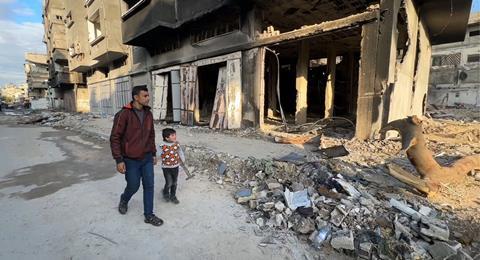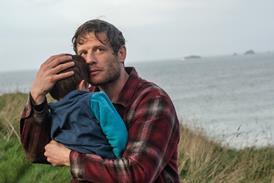Creatives behind Life and Death In Gaza on stresses and practicalities with contributors at constant risk of death
The creative team behind BBC2’s Life and Death In Gaza has opened up about the psychological and practical difficulties of working with contributors in an active warzone, including an incident when they thought one of them had died.
The feature-length BBC Storyville film hails from BBC Eye, and focuses on four Gazans – physiotherapist Khalid, women’s rights advocate Aya, youth worker Adam and pregnant mother Aseel – as they document their lives in the year since Hamas’ 7 October attack.
Producer Haya Al Badarneh told Broadcast the quartet was constantly at risk of bombs and airstrikes and despite being in touch with the BBC team daily, contact could be lost for days at a time amid internet blackouts and air strikes in the region.
“We lost contact with Khalid for two weeks after a huge airstrike near his house which killed hundreds of people. He went radio silent and that was all the information we had, so we thought it was quite likely he was dead,” she said.
The four, she continued, would often send her their final goodbyes because of the threat, noting they “would send videos and voice-notes when airstrikes became very heavy and they thought they might die, asking me to send their message to the world”.
“We lost contact with Khalid for two weeks after a huge airstrike near his house…We thought it was quite likely he was dead”
Haya Al Badarneh
“They wanted us to share their stories with nothing added or removed, to tell the world the truth about what is happening,” she said.
Al Badarneh said their plight would elicit feelings of guilt in her, recalling the times she lost her appetite knowing she had easy access to food compared with the Gazans. But she said the support of her team and the wider BBC helped drive the doc’s focus.

“Worrying about their safety was about 50% of the work that we put into this film,” agreed lead producer Lara El Gibaly.
El Gibaly said the strong relationships forged were also due to the contributors’ reliance on the production team to share crucial information about the war.
“It was a very unusual power dynamic because they weren’t just contacting us to send over material - they wanted us to share international news with them so they could understand which areas of Gaza might be safest,” she said.
“We were a lifeline, and we lived all the details of the war with them. That forged a stronger bond than would normally be the case.”
For Al Badarneh and El Gibaly, it was also important for the film to show mundane moments as well as levity, amid footage of fear and terror.
“We took a conscious decision not to shy away from reality as it is, not to santise what was going on,” El Gibaly said. “But you can’t make a 90-minute film that is just war and carnage.
“I hope when people see it they are surprised by moments of joy and moments of boredom in this environment of pain and struggle. We wanted to reflect that range of emotions.”
She pointed to the “strong-willed” Aya as someone who the audience will particularly connect with, saying she has a “zest for life” and “so much ambition”, particularly to document the experiences of women and children in Gaza.
Quality of footage
Director Natasha Cox weighed in on the challenges of piecing together a film which mainly relied on user-generated content (UGC), calling it a “huge risk” not to have footage from a camera team on the ground.
“We asked them to film their individual experiences without asking too many questions,” she said, adding contributors were urged to only to film their immediate environments and keep themselves as safe as possible.
“Once we got the material, we had to work out what it is that defines our contributors, which stories we felt represented their experiences, and how these stories would sit next to each other,” Cox explained.
Naturally, the quality of the UGC varied, depending on the different types of mobile phone video cameras being used and the degree of filming experience among contributors.
In the early stages of the production, she had to guide the contributors on the best techniques, reminding them to film horizontally rather than vertically. Though she admitted, the team “haven’t interfered that much”.
“What makes it so unique is that you don’t feel the producer’s hand. There will be lots of films [about the Gaza/Israel conflict] coming out in the next few months and I think it is important this one is sold on that premise,” she said. “Fundamentally they have told the story themselves, and we just gave them platform to do that.”
Life and Death In Gaza will air on BBC2 this evening (15 October) at 9pm.





























No comments yet